#Data Analytics course
Explore tagged Tumblr posts
Text
Full Stack Developer vs. Front End Developer vs. Back End Developer
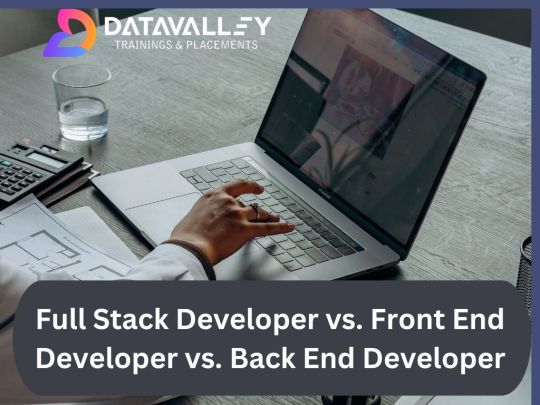
The role of a web developer is always included in the lists of high-paying IT jobs. This is because web developers are essential in today’s digital world. They create amazing websites, high-performing e-commerce sites, and other web-based applications. If you want to be a web developer, you must understand that full-stack developer skills are in great demand. However, do you understand the differences between full-stack, front-end, and back-end web development? In this post, we’ll see the differences between these three job roles, skills, and salaries.
What is Web Development?
The process of developing a website on the internet is known as web development. The non-design components of a website, such as building features and functioning with programming, markup, and scripting languages, are referred to as web development. Developers focus on technical aspects of website development such as architecture, programming, and application integration, as well as visuals.
A web developer is someone who does the following:
Creates and maintains webpages and other web-based applications.
Creates a website from a web design.
They collaborate with clients, stakeholders, and designers to understand the concept.
Can focus on frontend or backend development. Even as a full-stack developer, if necessary.
Types of Web Development
Front End Development: This aspect of web development focuses on what the user interacts with directly, i.e., the user interface of a website or web application. Front-end development deals with the design, layout, and interactivity of a site, ensuring that it’s visually appealing and user-friendly.
Back End Development: The back end is the part of a website or application that operates behind the scenes. It manages data, user authentication, and the server-side logic, ensuring the smooth functioning of the website.
Now, let’s delve into each of these roles in detail.
What is front-end development?
Front-end development, often referred to as client-side development, is the process of creating the visual elements of a website or web application that users interact with directly. It involves writing code for the user interface, optimizing website performance, and ensuring the site looks and functions correctly on various devices and browsers.
Who is a front-end developer?
A front-end developer, also known as a client-side developer, is responsible for turning web designs into a functioning website or application. They work closely with web designers and back-end developers to create an engaging and responsive user experience.
What are the front-end developer’s skills?
Front-end developers should be proficient in the following skills:
Mastery of HTML (Hypertext Markup Language) and CSS (Cascading Style Sheets) is fundamental for structuring and styling web pages.
Proficiency in JavaScript is crucial for adding interactivity and dynamic features to a website.
Knowledge of front-end frameworks like React, Angular, or Vue.js, which simplify and expedite development.
The ability to create websites that look and function well on various devices and screen sizes.
Ensuring that the website performs consistently across different browsers.
Familiarity with version control systems like Git for code management and collaboration.
Front End Developer Salary
The salary of a front-end developer can vary based on factors such as experience, location, and the company. On average, junior front-end developers can earn between $50,000 and $70,000 annually, while senior front-end developers can command salaries ranging from $90,000 to $120,000 or more.
What is Back End Development?
Back-end development, often referred to as server-side development, focuses on the server and database sides of a website or web application. It involves building and maintaining the server, databases, and applications that enable the front end to function correctly.
Who is a Back End Developer?
A back-end developer is responsible for managing the server, databases, and server-side logic of a website or application. They ensure that data is stored securely, accessed efficiently, and transmitted effectively between the front end and back end.
What are Back End Developer Skills?
Back-end developers should have expertise in the following areas:
Server-Side Programming Languages: Proficiency in languages such as Python, Ruby, Node.js, PHP, or Java is used to build server-side applications.
Databases: Knowledge of database management systems like MySQL, PostgreSQL, MongoDB, and NoSQL databases.
APIs: The ability to create and manage APIs (Application Programming Interfaces) for communication between the front end and back end.
Server Management: Skills in managing web servers and server infrastructure.
Security: Understanding web security practices and techniques to protect user data.
Version Control/Git: Proficiency in version control systems to manage and collaborate on code.
Back End Developer Salary
Back-end developer salaries can also vary based on experience, location, and the organization. Junior back-end developers can earn an annual salary ranging from $60,000 to $90,000, while senior back-end developers can expect salaries ranging from $100,000 to $150,000 or more.
Frontend vs. Backend Development
Front-end and back-end development are two halves of a whole, and they must work together seamlessly to create a functional website or application. While front-end developers focus on user interface and design, back-end developers deal with the underlying server infrastructure and data management. Both roles are essential for a successful web project.
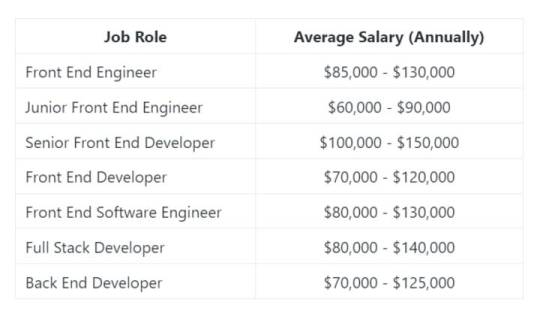
What is a Full Stack Developer?
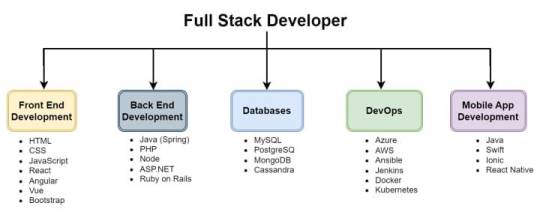
Who is a Full Stack Developer?
A full stack developer is a well-rounded professional who can take care of every aspect of web development, from designing the user interface to managing databases and server-side logic. They bridge the gap between front end and back-end development, ensuring that the entire application functions cohesively.
What are the Full Stack Developer Skills?
Full stack developers need a broad range of skills, including:
HTML/CSS: Proficiency in front end technologies for web page structuring and styling.
JavaScript: Mastery of JavaScript for creating dynamic and interactive web elements.
Front End Frameworks: Knowledge of front-end frameworks for efficient development.
Server-Side Programming Languages: Expertise in languages like Node.js, Python, Ruby, or Java for server-side development.
Databases: Proficiency in database management systems for data storage and retrieval.
APIs: Ability to create and manage APIs for communication between the front end and back end.
Version Control/Git: Familiarity with version control systems for code management.
Problem-Solving: Strong analytical and problem-solving skills to troubleshoot and optimize web applications.
Full Stack Developer Salary
Full-stack web developers are in high demand due to their range of skills and extensive knowledge. An average full stack developer’s annual salary might range from $110,000 to $150,000, based on their skill set and expertise.
Full-stack engineers earn more money than front end or back end developers. Employers agree to pay more for a full stack developer since it makes more business sense to hire one person with front and back end expertise rather than two.
As a result, the profession of a full stack developer is a profitable alternative for aspirants looking to create a career in the digital business.
The choice between becoming a full stack developer, front end developer, or back end developer depends on your interests, strengths, and career goals. Front end developers excel at creating visually appealing and user-friendly interfaces; back end developers focus on the server-side and data management; and full stack developers possess a comprehensive skill set that allows them to manage the entire development process. Each role is integral to the web development ecosystem, and the right one for you depends on your passions and aspirations within the field.
If you’re considering the path of a full stack developer and are eager to acquire the comprehensive skill set required to excel in this role, we have an excellent suggestion for you. Consider enrolling in the Full Stack Developer course at Datavalley.
Datavalley has a stellar track record of empowering aspiring developers with the knowledge and expertise to succeed in the dynamic world of web development. Their course covers everything from the fundamentals of HTML and CSS to in-depth training in JavaScript, front end and back end frameworks, and much more.
By joining Datavalley’s Full Stack Developer course, you’ll gain hands-on experience, build an impressive portfolio, and be well-prepared for a rewarding career in web development.
Don’t miss out on this opportunity to kickstart your journey as a Full Stack Developer with Datavalley. Your future in web development awaits. Take the first step today!
Attend Free Bootcamp at Datavalley
If you’re looking to supercharge your Java development skills and become a full-stack Java developer, consider joining the Java Full Stack Developer bootcamp at Datavalley. It’s an excellent opportunity to enhance your expertise and take your career to the next level.
Key points about Bootcamps:
It is completely free, and there is no obligation to complete the entire course.
20 hours total, two hours daily for two weeks.
Gain hands-on experience with tools and projects.
Explore and decide if the field or career is right for you.
Complete a mini project.
Earn a certificate to show on your profile.
No commitment is required after bootcamp.
Take another bootcamp if you are unsure about your track.
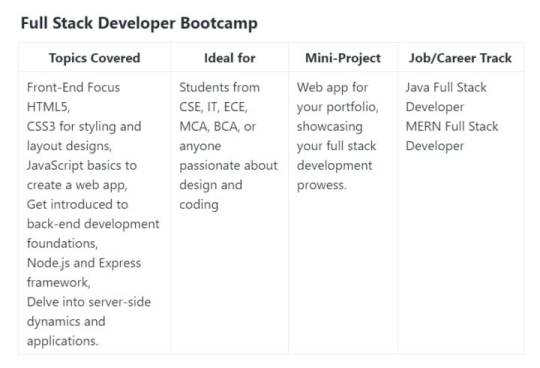
#datavalley#dataexperts#data engineering#data analytics#dataexcellence#business intelligence#data science#power bi#data analytics course#data science course#full stack course#full stack training#full stack web development#full stack developer#full stack software developer#front end developers#back end development
7 notes
·
View notes
Text
No One Will Ever Teach You About Data Analytics in a Very Simple Way with Real-Time Examples
In today's modern digital world, data is all around us. Every time you use your smartphone, buy something online, or share something on social media, you're creating data. But why is data important, and how can we use it to make better decisions? That's where data analytics comes into play, and in this blog, we'll explain it in simple terms.

What is data analytics?
At its core, data analytics is like a detective for the digital world. It's the process of looking closely at data, cleaning it up, changing it into useful information, and figuring out what it tells us. This information helps people and organisations make smart choices, solve problems, and even guess what might happen in the future.
How does data analytics work?
Imagine you run a small ice cream shop in your neighborhood. You sell different flavours, from classic chocolate to unique mango. To run your shop well, you need to make good choices about which flavours to have and when to offer them. That's where data analytics can help, and I'll show you how it works using a simple example.

Data Collection
Every day, you keep a record of which ice cream flavours you sell and keep an eye on the weather. You also note whether it's a regular weekday or a fun weekend.
Data Analysis
After a few months, you have a pile of notebooks filled with sales data. You use a special computer programme to look at all this information.
Descriptive Analytics: You make graphs and charts to see which flavours are liked the most. For instance, you notice that chocolate sells well all year.
Diagnostic Analytics: Digging deeper, you discover patterns, like mango ice cream being a hit on hot weekends and vanilla being popular on weekdays.
Predictive Analytics
Here's where it gets exciting. Using past data, your analytics tool can make guesses. It tells you that the next weekend will be very hot. So, you decide to order more mango ice cream to be ready for the extra demand.
Prescriptive Analytics
Now, it's not just about guessing. You also get advice on what to do. Your analytics tool suggests that during the weekdays, you could offer a discount on vanilla to bring in more customers.
Implementing Changes
You follow the advice and give discounts on vanilla during the weekdays. You also make sure to have plenty of mango ice cream for the upcoming hot weekend.
Seeing Results
When the hot weekend comes, customers are happy to see lots of mango ice cream, and sales go up. On weekdays, the discount on vanilla brings in more customers and boosts sales.
This process keeps going, and you continue using data analytics to make good choices about flavours, discounts, and how much ice cream to have in stock. Your ice cream shop becomes more successful because you're using data to understand what customers like and how the weather affects sales.
In short, data analytics is like having a crystal ball for your business. It helps you understand what happened in the past (descriptive), why it happened (diagnostic), guess what might happen in the future (predictive), and suggest what you should do about it (prescriptive). Whether you run an ice cream shop or a big company, data analytics helps you make smarter decisions in real-time.
If you want to learn more about data analytics or need help using it in your business, you can talk to experts or take specialised courses. For example, ACTE Institute offers comprehensive data analytics training programmes that can give you the knowledge and skills you need, including job placement and certification. So, get ready to learn, explore the tools, and start turning data into valuable insights!
12 notes
·
View notes
Text
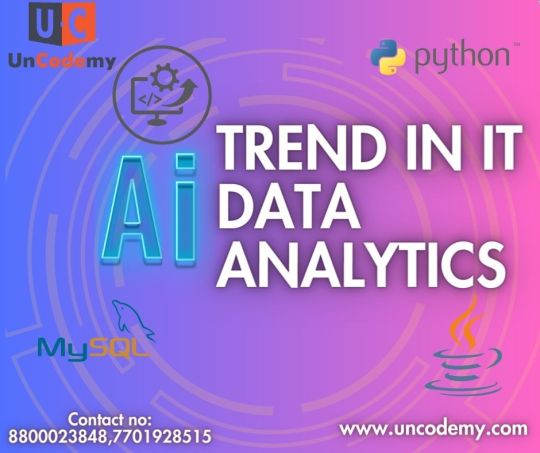
Unlock the power of data with our comprehensive Data Analytics Training Course in Agra! Gain in-depth knowledge of advanced analytics, artificial intelligence, and big data techniques.
3 notes
·
View notes
Text
youtube
Welcome to Imarticus Learning! Time Series Modelling lies at the core of forecasting across industries like finance, retail, supply chain, and healthcare. In this video, we explore the fundamentals of time series data, key components such as trend and seasonality, and how models like ARIMA, SARIMA, and Prophet can help us predict future outcomes with greater accuracy. If you've ever wondered how businesses forecast sales, demand, or stock prices—this is the video you need to watch.
We begin by explaining what time series data is and how patterns and dependencies are identified. You'll gain clarity on crucial elements like trend, seasonality, cyclicity, and noise, followed by a walkthrough of widely-used models such as ARIMA, SARIMA, and Prophet, along with their real-world applications. We also cover model evaluation techniques like AIC, RMSE, and cross-validation to help you understand how to assess forecasting performance effectively.
What makes this video especially relevant is that it lays the foundation for mastering advanced AI and ML tools—essential skills if you're looking to enroll in the best data science and analytics course. At Imarticus Learning, our expert-led training ensures that you not only learn the concepts but also apply them in hands-on projects that mirror industry demands.
With flexible learning formats, expert mentorship, mock tests, and structured study materials, Imarticus is committed to making your upskilling journey seamless and impactful. Our goal is simple: to help you grow your career and stand out in the competitive world of data science.
If you're serious about becoming an AI and ML expert capable of predicting, automating, and optimizing outcomes, explore our Postgraduate Program in Data Science and Analytics (PGA). This 6-month intensive course is designed for graduates and early professionals, offering 100% job assurance through 2,000+ hiring partners, over 300 learning hours, 25+ industry-aligned projects, and training in more than 10 essential tools including Python, Tableau, and Power BI. With a highest salary of 22.5 LPA and average salary hikes of 52%, it’s widely regarded as one of the best data science and analytics courses available today.
0 notes
Text
Data Analytics Explained: A Beginner's Guide to Techniques, Tools & Careers (2025)
Overview: The Data Revolution Has Arrived
Every purchase, social media interaction, and click produces useful data. Companies that use analytics to leverage this data beat the competition by 23% in 2025 (McKinsey). Regardless of your background—business owner, aspiring analyst, or curious professional—this guide will help you understand:
The true meaning of data analytics
The four essential categories of analytics
Tools and methods you should become acquainted with
How to begin a career in analytics
Together, let's unleash the power of data.
Data analytics: what is it? (And the Significance of It)
The science of turning raw data into actionable information is known as data analytics. You gather hints, examine trends, and resolve business mysteries—it's similar to being a data detective.

TheFive-Step Analytics Procedure:
Collection: Compiling information from IoT devices, apps, and websites
Cleaning: 80% of an analyst's time is spent eliminating mistakes and duplicates.
Analysis is the process of finding patterns using statistical techniques.
Visualization: Building Tableau/Power BI dashboards
Making Decisions: Using the Knowledge
Impact in the Real World:
Netflix uses recommendation analytics to save $1 billion annually.
Hospitals use predictive models to cut patient readmissions by 35%.
The Four Categories of Data Analytics (With Examples)
1. Descriptive Analytics: "What Happened?"
Goal: Recognize prior performance
Tools: Google Analytics and Excel
For instance, a monthly sales dashboard demonstrating a 15% increase in Q1
2. Diagnostic Analytics: "Why Did It Happen?"
Goal: Identify the causes
Methods: correlation and drill-down analysis
For instance, identifying a marketing campaign that produced 60% of new signups
3. Predictive Analytics: "What Will Happen?"
Goal: Predict upcoming trends
Tools: Machine Learning, Python
Example: Bank forecasting loan defaults with 92% accuracy
4. Prescriptive Analytics: "What Should We Do?"
Goal: Make action recommendations
Tools: platforms for artificial intelligence
Example: UPS saving $400M/year with optimized routes
2025's Top 3 Data Analytics Tools to Learn
Top 3 Data Analytics Tools to Learn in 2025
Tool
Best For
Learning Curve
Avg. Salary
Excel
Basic analysis
Easy
1,500,000 Rup
SQL
Database queries
Medium
7,225,000 Rup
Python
Advanced analytics
Hard
8,544,900 Rup
Pro Tip: Before moving on to Python, start with Excel and SQL. These fundamentals are required for most entry-level jobs.
Five Steps to Become a Data Analyst in 2025
Step 1: Lay the Groundwork
Learn the basics of statistics, including mean, median, and distributions.
Master Excel (VLOOKUPs, PivotTables)
Enroll in free courses: Google Data Analytics Certification (7-month course)
Step 2: Develop Technical Proficiency
SQL: Work with real databases.
Visualization: Create three exemplary dashboards
Python/R: Start by cleaning the data using the Pandas library.
Step 3: Create a Portfolio
Project Concept 1: Chart COVID-19 patterns using publicly available data
Project Concept 2: Establish a dashboard for sales performance
GitHub host: demonstrates technical proficiency
Step 4: Obtain Certification (Optional)
Suggested Certifications:
Analytics by Google
Certification for Microsoft Power BI
Professional in IBM Data Science
Step 5: Look for Your First Entry-Level Jobs:
Operations Analyst, Marketing Data Specialist, and Business Intelligence Analyst
Pay Range: 4LPA to 20LPA
Applications in the Real World Transforming Sectors
Medical Care
Forecasting patient admissions using predictive analytics
For instance, the Cleveland Clinic reduced readmissions for heart failure by 30%.

Retail Customer Analytics: Tailored suggestions
For instance, Target is aware that its customers are expecting before their relatives do.
Finding suspicious transactions is the first step in detecting financial fraud.
For instance, PayPal prevents more than $4 billion in fraud annually.
In conclusion, your data journey starts right now!
According to the U.S. Bureau of Labor Statistics, the data analytics sector is growing 25% faster than other occupations. Here's how to begin:
Practice every day by experimenting with free datasets (check out Kaggle).
Concentrate on marketing analytics, healthcare, or finance.
Network: Take part in local events and LinkedIn groups.
Are you prepared to proceed?
Enroll now for the 100% Placement Guaranteed Data Analytics Certification Course at Skyappz Academy in Coimbatore! https://skyappzacademy.com/data-analyst/
0 notes
Text
SQL Data Normalisation: Reducing Redundancy for Efficient Database Design
Efficient database design is crucial for maintaining data integrity and improving performance. One fundamental principle of good database design is data normalisation, a process that reduces data redundancy and ensures logical data storage. This article explores the concept of normalisation, its advantages, and the steps involved in implementing it effectively. If you are pursuing a data analyst course, understanding normalisation is essential for structuring databases efficiently.
What Is Data Normalisation?
Data normalisation is a systematic approach to organising data in a database. The primary goal is to minimise redundancy, prevent data anomalies, and ensure the database adheres to predefined rules called normal forms. These rules guide data structuring so that it is logically grouped, relationships are defined, and dependencies are properly managed. Normalisation involves dividing large tables into smaller ones and establishing relationships between them. Doing so eliminates duplicate data and ensures consistency throughout the database.
Why Is Data Normalisation Important?
Database normalisation has several benefits, such as improving business processes and cost savings. It enhances the effectiveness of data analysis in many ways, some of which are briefly described here.
Reducing Redundancy
Redundancy occurs when the same data is unnecessarily stored in multiple places. This not only consumes extra storage space but also makes updates cumbersome. For example, updating an employee's address in an unnormalised database might require changes in multiple tables or rows.
Improving Data Integrity
Normalisation ensures that data is consistent and accurate. Organising data into related tables greatly reduces the likelihood of data anomalies—such as insertion, update, or deletion anomalies—.
Enhancing Query Performance
Though normalisation can sometimes increase the complexity of queries, the organised structure allows for more efficient data indexing and retrieval.
Facilitating Scalability
A normalised database is easier to modify and scale. Adding new tables or attributes becomes more straightforward as new requirements emerge without disrupting the existing structure.
The Normal Forms in Database Design:
Normalisation is typically performed through a series of normal form (NF) stages, each addressing specific data redundancy and dependency issues.
First Normal Form (1NF): Eliminate Repeating Groups
A table is in 1NF if:
Each column contains atomic (indivisible) values.
Each row is unique.
For instance, a table storing multiple phone numbers in a single column violates 1NF. Splitting these into separate rows ensures compliance.
Second Normal Form (2NF): Remove Partial Dependencies
A table is in 2NF if:
It is already in 1NF.
All attributes, except the primary key, depend fully on the primary key.
This step removes partial dependencies, ensuring that non-key attributes depend on the composite key rather than a portion.
Third Normal Form (3NF): Remove Transitive Dependencies
A table is in 3NF if:
It is in 2NF.
There is no dependency between non-key attributes in this context.
This ensures that attributes depend only on the primary key, simplifying relationships.
Boyce-Codd Normal Form (BCNF): Strengthen Key Dependencies
BCNF is a stricter version of 3NF. It addresses scenarios where a table has overlapping candidate keys, ensuring every determinant is a candidate key.
Steps to Normalise a Database
For effective database normalisation, follow a systematic, step-by-step procedure. The main steps involved in such a procedure are described in the following sections.
Analyse the Data
Understand the structure and relationships between data points. Identify the attributes that will form the primary key, foreign keys, and dependencies.
Apply the Normalisation Rules
Start with 1NF and progress through the normal forms as necessary. Each step reduces redundancy and anomalies further.
Verify Relationships
Check that the tables are properly linked through foreign keys. These relationships enable data retrieval across multiple tables.
Optimise for Performance
While normalisation emphasises reducing redundancy, over-normalisation can lead to performance issues. Strike a balance between a normalised structure and query efficiency.
Challenges of Normalisation
Despite its benefits, normalisation is not without challenges:
Increased Complexity: Highly normalised databases can involve multiple tables, making queries more complex and potentially slower.
Storage Overheads: Foreign keys and indexes in normalised databases can consume additional storage.
Balancing Denormalisation: In some cases, partial denormalisation may be required to optimise performance for specific use cases, such as read-heavy operations.
Normalisation in Real-World Scenarios
Normalisation is applied across several industry domains and businesses. The following are a couple of real-world scenarios of the application of database normalisation.
E-commerce Platforms
Normalisation ensures that customer, product, and order information is stored in separate tables in an e-commerce database. This design avoids duplicating customer data across multiple orders and enables efficient updates.
Healthcare Systems
Healthcare databases often store patient records, doctor details, and treatment histories. Normalisation ensures these data sets are interconnected without redundancy, reducing the risk of inconsistent medical records.
Best Practices for Database Normalisation
Here are some best-practice guidelines commonly recommended by industry experts who draw from their experience of database normalisation practices.
Understand Business Requirements: Tailor the normalisation level to the application's specific needs.
Document Dependencies: Maintain clear documentation of data relationships and dependencies.
Use Tools and Software: Leverage database design tools to automate and validate the normalisation process.
Continuously Monitor Performance: Review database performance regularly to identify areas where denormalisation might benefit.
SQL data normalisation is a foundational principle for efficient database design. Normalisation ensures data integrity, consistency, and scalability by systematically reducing redundancy and managing dependencies. SQL data normalisation calls for careful planning and consideration of trade-offs. However, because the long-term benefits of SQL data normalisation far outweigh the initial complexities, many data analysts are enrolling in advanced courses such as a data analyst course that will help them master database normalisation—an essential step toward designing efficient and reliable databases.
0 notes
Text
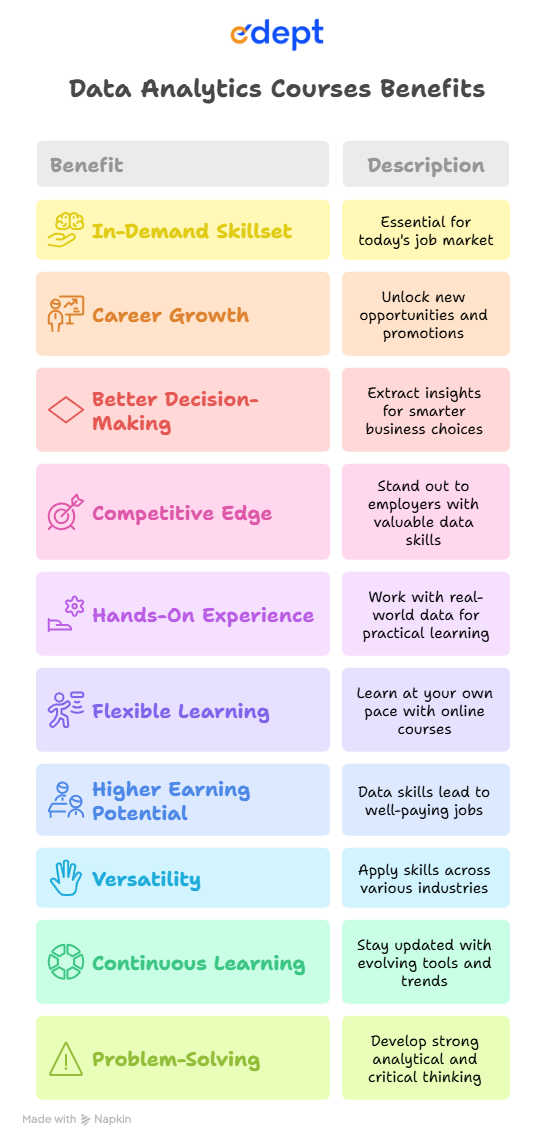
Key Benefits of Data Analytics Courses in India
Data analytics courses in India provide valuable benefits, including career advancement, improved decision-making, and a competitive advantage in the job market. These courses offer practical experience, flexible learning formats, and opportunities for high-paying roles in various sectors. With a focus on continuous learning and enhanced problem-solving skills, data analytics helps you stay ahead in today’s rapidly evolving, data-driven world.
0 notes
Text
The Future of Full Stack Java Development

Full-stack developers, also known as “jack of all trades,” are in high demand in India. They are capable of carrying out the duties of numerous professionals. They earn good money and have many job opportunities with rewarding experiences because of their diverse skills. Full-stack Java programming has a bright future because its popularity is growing and will continue to grow in the coming years.
It’s well known that full-stack developers are proficient in both server-side and client-side programming. They are the professionals who carry out the responsibilities of backend and frontend developers. Despite not always being regarded as specialists, their abilities enable them to handle development tasks with ease. All firms look forward to having a brilliant full-stack developer as a future developer for a number of reasons. They handle a variety of technologies, which enables them to manage more project facets than the typical coder.
An experienced web developer who primarily works with Java programming is known as a Java full-stack developer. The front end, back end, and database layer are the three levels of code that these web developers build. The web development teams are frequently led by full-stack Java engineers, who also assist in updating and designing new websites. Because there is a great demand for Java full-stack developers. Many institutions have seized the opportunity by providing well-thought-out Java full-stack developer courses. You may study full-stack development quickly and become an expert in the area with the aid of these courses.
Java Full Stack Development by Datavalley
100% Placement Assistance
Duration: 3 Months (500+ hours)
Mode: Online/Offline
Let’s look into the future opportunities for full-stack Java professionals in India.
4 things that will Expand the Future Purpose of Java Full-Stack Developers
The Role of a Full-Stack Developer
Full-stack developers work on numerous tasks at once. They need to be extremely talented and knowledgeable in both front-end and back-end programming languages for this. JavaScript, CSS, HTML, and other frontend programming languages are essential. When creating new websites or modifying old ones, Java is a key programming language used by Java full-stack developers. However, backend programming languages consist of .Net, PHP, and Python depending on the projects. The full stack developers are distinguished from other developers by their proficiency and understanding of programming languages. With the availability of the finest Java full stack developer training, students may now easily master a frontend programming language like Java. The full-stack developer is more valuable and in demand when they are knowledgeable in multiple programming languages.
Responsibilities of a Full-Stack Developer
Functional databases are developed by full-stack developers. It creates aesthetically pleasing frontend designs that improve user experience and support the backend. The entire web-to-web architecture is under the control of these full-stack developers. They are also in charge of consistently maintaining and updating the software as needed. The full-stack developers bear the responsibility of overseeing a software project from its inception to its finalized product.
In the end, these full-stack developers also satisfy client and technical needs. Therefore, having a single, adaptable person do many tasks puts them in high demand and increases their potential for success in the technology field. Through extensively developed modules that expand their future scope, the Java full-stack developer course equips students with the skills necessary to take on these tasks.
The full-stack developer salary range
Full-stack developers are among the highest-paid workers in the software industry. In India, the average salary for a full-stack developer is 9.5 lakhs per annum. The elements that determine income typically include experience, location of the position, company strength, and other considerations. A highly skilled and adaptable full-stack developer makes between 16 and 20 lakhs per annum. Full-stack engineers get paid a lot because of their extensive skills, they can handle the tasks of two or three other developers at once.
By fostering the growth of small teams, preventing misunderstandings, and cutting the brand’s operating expenses, these full-stack developers perform remarkable work. Students who take the Java full-stack developer course are better equipped to become versatile full-stack developers, which will increase their demand currently as well as in the future in the industry.
Job Opportunities of Java Full Stack Developers
The full-stack developers are knowledgeable professionals with a wide range of technological skills. These competent workers are conversant with numerous stacks, including MEAN and LAMP, and are capable of handling more tasks than a typical developer. They are skilled experts with a wealth of opportunities due to their extensive understanding of several programming languages.
Full-stack developers are in high demand because they can work on a variety of projects and meet the needs of many companies. The full-stack Java developer course helps students build this adaptability so they can eventually become the first choice for brands searching for high-end developers.
As a result, these are a few key factors improving the future prospects of Java Full Stack developers in India. They are vibrant professionals who are in high demand due to their diverse skill set and experience, and they are growing steadily. The Java full stack developer course can help students hone their knowledge and abilities to succeed in this industry.
Datavalley’s Full Stack Java Developer course can help you start a promising career in full stack development. Enroll today to gain the expertise and knowledge you need to succeed.
Attend Free Bootcamps
Looking to supercharge your Java skills and become a full-stack Java developer? Look no further than Datavalley’s Java Full Stack Developer bootcamp. This is your chance to take your career to the next level by enhancing your expertise.
Key points about Bootcamps:
It is completely free, and there is no obligation to complete the entire course.
20 hours total, two hours daily for two weeks.
Gain hands-on experience with tools and projects.
Explore and decide if the field or career is right for you.
Complete a mini-project.
Earn a certificate to show on your profile.
No commitment is required after bootcamp.
Take another bootcamp if you are unsure about your track.

#dataexperts#datavalley#data engineering#data analytics#dataexcellence#business intelligence#data science#power bi#data analytics course#data science course#java developers#java full stack bootcamp#java full stack training#java full stack course#java full stack developer
2 notes
·
View notes
Text
Exploring the World of Data Analytics: Opportunities and Beyond
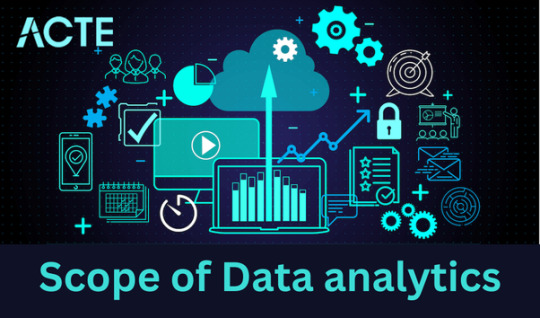
Describe data analytics. Analyzing data to find useful information, patterns, and trends is known as data analytics. Businesses adore it since it aids in their improvement. It’s similar to solving problems with data.
Why is data analysis so crucial? Consider yourself in possession of a treasure map (data) and the desire to locate the treasure (insights). Your compass is data analytics.
Why it matters is as follows: It aids in your understanding of consumer behavior, market trends, and company performance.
Efficiency: You can discover areas in which your company may save both time and money.Smart decisions: When using data, you may base decisions on facts rather than educated guesswork.
Personalization: Have you ever seen how Netflix suggests shows? That is data analysis.
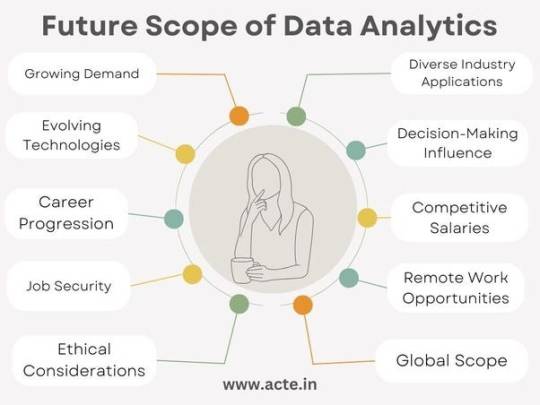
Future Scope of Data Analytics :
High Demand: Many businesses in different industries need data experts because they use data to make smart choices. So, the need for skilled data analysts is growing.
Various Job Fields: Data skills are useful everywhere, not just in one industry. You can work in finance, healthcare, e-commerce, marketing, or technology. This means you have many options for your career.
Tech Keeps Changing: The tools and methods for working with data keep getting better and different. It’s important to keep learning new things, but it also means you can become an expert in a special area.
Helping Decisions: Data people play a big role in helping businesses make important decisions. What you find in data can change how a company plans for the future.
Career Growth: Starting as a data analyst can lead to better and higher-paying jobs like data scientist or machine learning engineer.
Good Pay: Data analysts are paid well. As you get better at your job, you can earn even more.
Job Security: As long as companies use data, they’ll need people who understand it. So, you’ll have a stable job.
Work from Anywhere: You can often do data work from anywhere, giving you flexibility in where you live.
Ethical Data: Data privacy and being fair with data are important. People who can make sure data is used the right way are in demand.
Worldwide Opportunities: Data skills are needed all over the world, so you
can work in different countries if you want.
Careers in Data Analytics:
Data Analyst: The entry point They collect, clean, and analyze data.
Data Scientist: The Experts They use machine learning to solve complex puzzles.
Business Analyst: The bridge between data and business decisions
Big Data Engineer: They manage massive data sets using big data tools.
Healthcare Analyst: They use data to improve healthcare outcomes.
Marketing Analyst: Masters of measuring marketing success
Financial Analyst: They use data for financial strategies.
Sports Analyst: They play with data in the world of sports.
The Future of Data Analytics:
AI and machine learning: Think smarter, not harder. Automation will rule.
IoT Analytics: Connected devices will provide more data than ever.
Ethical Analytics: Data privacy will be a top concern.
Data Visualisation: Making data pretty and easy to understand will be big.

Feel free to get in touch with an ACTE institution if you want to learn more about Data Analytics because they provide certifications and possibilities for job placement. Teachers with experience can improve your learning. These services are available offline and online. Take things slowly and, if you’re interested, think about signing up for a course.
I hope I was able to effectively respond to your query. If it’s not, add it in the comments section. I still think I have a lot to learn.
Consider following me and giving this answer an upvote if you found it to be useful. This will motivate me to post more information on data analytics.
We appreciate you taking the time to read this and voting it up. Enjoy your day.
#data analytics#data analysis#data analytics course#data analyst jobs#data analyst training#data analyst certification#data analyst course
3 notes
·
View notes
Text

Full stack development is a comprehensive approach to web application or website development that encompasses both front-end and back-end technologies. It enables developers to work on all aspects of a project, making it a versatile and sought-after skill in the IT industry. For more information about Data Analytics course in Gorakhpur
2 notes
·
View notes
Text
youtube
In today’s video, we’re breaking down two of the most commonly used algorithms in machine learning: K-Nearest Neighbors, also known as KNN, and Support Vector Machine, or SVM. If you’re looking to understand how these models work and when to use them, you’re in the right place.
We’ll start with KNN—a simple but powerful method that makes decisions by looking at its nearest neighbors in the data. Then, we’ll move on to SVM, which finds the best boundary between different groups using lines or curves. We’ll also compare both models side by side, talk about where they perform best, and walk through real-world examples using important metrics like accuracy, precision, and recall.
Whether you're just getting started or building on your machine learning knowledge, this video will help you understand these topics in a simple and practical way.
Now, if you're serious about learning machine learning and looking for the best machine learning course, let me tell you about the Postgraduate Program in Data Science and Analytics by Imarticus Learning. It’s a 6-month course designed for fresh graduates and early professionals. You get over 300 hours of learning, more than 25 hands-on projects, and training in tools like Python, Power BI, and Tableau. Plus, there’s a 100% job guarantee with over 2,000 hiring partners, and top learners have landed packages as high as 22.5 LPA.
So if you're ready to build your career in data science and analytics, this is your chance to join the best machine learning course and lead the future of AI.
#Data Science Course#Data Analytics Course#Best Data Science Course Online#Data Science#Machine Learning#Data Analytics#Youtube
0 notes
Text
Transform Numbers into Opportunities: Master Data Analytics in Pune
In today’s fast-paced digital era, data has become the backbone of decision-making processes across industries. Organizations are increasingly relying on skilled professionals to extract meaningful insights from vast amounts of information. This has created a soaring demand for experts in data analytics. Pursuing data analytics training in Pune can be your stepping stone toward a promising and future-proof career.
Why Pune is Ideal for Data Analytics Training
Pune has established itself as a leading center for education and technology. With a thriving IT industry and numerous multinational companies, the city offers abundant opportunities for aspiring data professionals. Enrolling in a reputable data analytics training in Pune means you not only get access to high-quality education but also to a strong network of industry experts, internships, and job openings.
Key Components of Data Analytics Training
A robust data analytics program covers several critical areas, including:
Data Collection and Cleaning: Learning techniques to gather and refine raw data.
Statistical Analysis: Applying statistical methods to uncover patterns and relationships.
Data Visualization: Creating impactful reports and dashboards using tools like Tableau and Power BI.
Programming Languages: Mastering Python, R, and SQL for data manipulation and analysis.
Machine Learning Basics: Understanding predictive modeling and algorithmic strategies.
By gaining expertise in these areas through data analytics training in Pune, you prepare yourself to solve real-world business challenges effectively.
The Value of a Data Analyst Certification
While training provides the necessary skills, formal recognition of your expertise adds an extra layer of credibility. Earning a data analyst certification in Pune not only validates your knowledge but also enhances your resume, making you stand out in a competitive job market. Many companies prefer certified candidates as it assures them of your technical proficiency and commitment to continuous learning.
A data analyst certification in Pune often includes rigorous coursework, hands-on projects, and exams that test your ability to handle practical data problems. This process ensures that you are well-prepared to meet industry expectations.
How to Choose the Right Training Institute
When selecting a course or institute, it’s important to evaluate:
Experienced faculty with industry exposure
Updated curriculum matching current market trends
Hands-on training with live projects
Placement assistance and career support services
Flexible learning options (classroom or online)
Choosing the right place for your data analytics training in Pune can significantly impact your career trajectory.
Why ITView is the Best Choice for Data Analytics Training
ITView is the go-to institute for the best data analytics training in Pune if you are serious about building a career in data analytics. ITView offers a comprehensive, industry-aligned curriculum taught by seasoned professionals. Their approach combines theoretical learning with hands-on experience, ensuring students are job-ready by the end of the course.
Moreover, ITView provides full support for students aiming to earn their data analyst certification in Pune. With a strong focus on practical skills, career counseling, and placement assistance, ITView empowers you to confidently step into the world of data analytics and achieve your professional goals.
0 notes
Text

Open new horizons of data with the Full Stack Data Science course, wherein all layers are essential, from data collection to cleaning to analysis to machine learning to deployment. The course is geared toward mentees seeking to understand the real data science lifecycle. Aiming to be a data scientist or analyst or ML engineer? This program gives hands-on training on tools such as Python, SQL, Pandas, Scikit-learn, TensorFlow, and deployment platforms. Build world-class projects, enhance your portfolio, and develop the confidence to solve business problems using data.
#best data science course#full stack data science course#data science course#virtual internship#data analytics course online#campus ambassador programs#best data analytics course online#data analytics course
0 notes
Text
How to Ask the Right Questions in Data Analytics

In the modern age, data is all around us. Companies collect huge amounts of information every day. But simply gathering data isn’t enough. To use it in a smart way, it’s important to know how to ask the right questions. In the field of data analytics, well-thought-out questions are the key to unlocking useful answers. Let’s look at how you can ask the right questions to make the most of your data.
Why Good Questions Are Important
Data doesn’t speak for itself. It needs to be explored and studied. That process begins with asking the right questions. A clear question helps focus the analysis, saves time, and leads to results that matter.
Think of it like this: if you walk into a bookstore without knowing what you’re looking for, you might waste a lot of time. The same thing applies to data. Without a clear question, you may spend hours digging into numbers without getting any helpful insight.
Start With the Problem
Before jumping into questions, first understand the issue you're trying to fix. A good question starts with a clear understanding of the problem. Ask yourself:
What outcome do I need?
What decision depends on this?
Who needs the answer?
For instance, if a business notices a drop in online orders, a useful question would be: “What is causing the drop in online orders over the last month?” That’s much more helpful than a broad question like, “What’s wrong with sales?”
Being specific gives you a better chance of finding a real solution.
Follow the SMART Method
One easy way to form strong questions is by using the SMART method:
Specific – Straight to the point
Measurable – Can be tracked with numbers
Actionable – Leads to steps you can take
Relevant – Connected to business goals
Time-based – Covers a time period
Instead of asking, “How are customers doing?” ask, “How did our customer service scores change in the past two months compared to the two months before that?”
This kind of question is easier to work with and gives better results.
Know Who You’re Asking For
The question you ask should fit the needs of the person or team that wants the answer. A product team might want to know which features users love, while a sales team may want to know which product sells best.
Ask yourself:
Who is asking for the data?
What decision do they need to make?
How will this answer help them?
This way, you create questions that are focused and useful for the right people.
Break Big Questions Into Smaller Ones
Large questions can feel overwhelming. It’s often smarter to split them into smaller parts. For example:
Big question: “Why are customers not coming back?”
Smaller questions:
Has the number of returning customers dropped recently?
Are certain products not performing well?
Are there changes in customer reviews?
Each of these smaller parts can be studied separately, and together they help answer the bigger question.
If you’re just starting in this field, joining offline data analytics courses in Ahmedabad can help you learn how to break down real-world problems and build the right questions to solve them.
Let Data Shape the Next Question
When you get an answer from your data, use it to form the next question. This way, each step leads you further into understanding the issue.
For example, if you learn that users often leave your website after visiting one page, you might next ask, “Which pages are people exiting the most?”
This step-by-step method helps dig deeper and find meaningful answers.
Keep Questions Clear and Simple
Don’t use fancy or hard-to-understand language when forming your questions. Simple wording makes questions easier to understand and answer.
Complicated: “What is the standard deviation in quarterly engagement levels by device type?”
Simple: “Which devices do people use most during each quarter?”
The clearer your question, the easier it is to analyse the data and share results with others.
Build the Habit of Asking Better Questions
Learning to ask good questions is a skill you can grow over time. Whenever you see a chart or report, ask:
What does this show?
What could be the reason?
What else should I know?
Asking these questions regularly helps you become better at finding value in data.
If you want to grow your knowledge and get hands-on experience, consider enrolling in a Data analytics institute in Ahmedabad. Many of these programs focus on real data projects and teach how to ask the kinds of questions that drive smart business decisions.
Asking the right questions is the heart of successful data analytics. The better your questions, the more useful your answers will be. With a clear purpose, a simple approach, and a focus on the real problem, you can use data to make smart and informed choices.
This skill is helpful in any role and is becoming more important as businesses continue to rely on data. Start practicing, and you’ll soon see how powerful good questions can be.
#data analytics#data analytics course#data analytics course in ahmedabad#data analytics institute in ahmedabad
0 notes